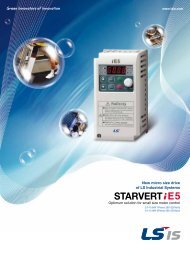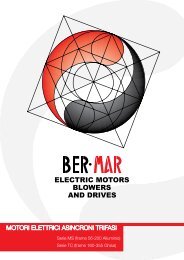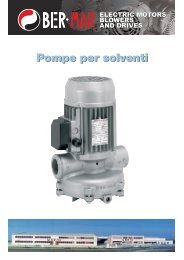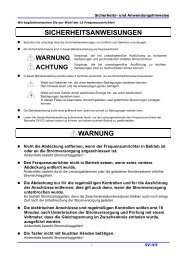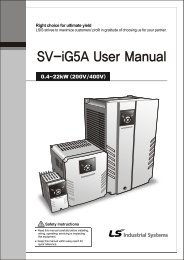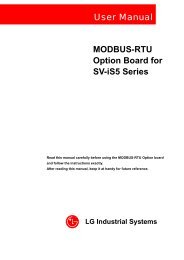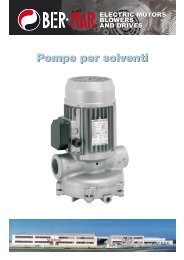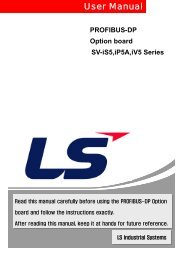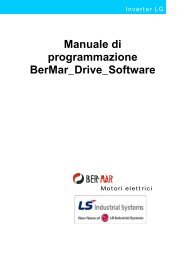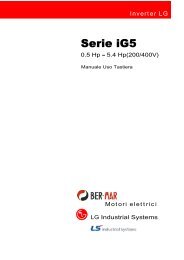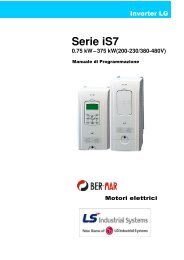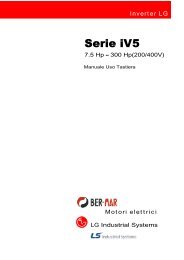Motori Elettrici Autofrenanti - Bermar.it
Motori Elettrici Autofrenanti - Bermar.it
Motori Elettrici Autofrenanti - Bermar.it
You also want an ePaper? Increase the reach of your titles
YUMPU automatically turns print PDFs into web optimized ePapers that Google loves.
1 V<strong>it</strong>i di fissaggio<br />
DIN 912 u. 6912<br />
Machine screw<br />
2 Magnete<br />
Magnet<br />
3 Indotto<br />
Armature<br />
4 Anello di regolazione<br />
Adjustment ring<br />
5 Molla<br />
Pressure spring<br />
6 Mozzo<br />
Hub<br />
7 Ferodo<br />
Lining<br />
Disco di frizione secondario (8) e leva di sblocco (10) sono accessori.<br />
The friction disc (8) and handrelease (10) are accessories.<br />
B1<br />
31.003-4-066<br />
8 Disco di frizione<br />
secondario<br />
Secondary friction<br />
surface<br />
9 Distanziale<br />
Adjustable spacer<br />
10 Leva di sblocco<br />
Hand release<br />
Caratteristiche funzionali<br />
Il freno a molla viene bloccato con le v<strong>it</strong>i di fissaggio (1).<br />
Con le v<strong>it</strong>i (1) allentate è possibile la regolazione del traferro<br />
alla quota nominale X (Pag. 6, T1) ruotando il distanziale<br />
(9). Dopo aver effettuato la regolazione stringere le<br />
v<strong>it</strong>i (1) ed il freno è pronto per lavorare.<br />
In assenza di tensione l’indotto (3) ed il ferodo (7) sono<br />
pressati contro la superficie di fissaggio tram<strong>it</strong>e la molla<br />
centrale (5). Il ferodo (7) è libero assialmente ma bloccato<br />
torsionalmente tram<strong>it</strong>e il mozzo (6).Il mozzo deve invece<br />
essere bloccato assialmente e torsionalmente sull’albero.<br />
Dando tensione alla bobina il magnete (2) crea un campo<br />
magnetico che attrae l’indotto (3). A causa di ciò il ferodo<br />
(7) è rilasciato e l’albero può ruotare liberamente.<br />
Functional Characteristics<br />
Spring brake is attached w<strong>it</strong>h the fastening screws (1).<br />
W<strong>it</strong>h the screws loosened the clearance is adjusted to the<br />
nominal dimensions X (page 6, T1) by turning the adjustment<br />
pieces (9). After carrying out a uniform adjustment of<br />
the clearance the screws (1) are tightened and the brake<br />
is ready for operation.<br />
In a currentless state the armature disc (3) and the friction<br />
lining (7) are pressed against the attachment surface by<br />
the central spring. The friction lining (7) is torsional-free<br />
but axial-movable connected w<strong>it</strong>h the hub (6). The hub is<br />
firmly mounted on the shaft thereby blocking <strong>it</strong>.<br />
After applying the voltage the direct-current coil of the<br />
magnet (2) creates a magnetic field which attracts the<br />
armature discs (3). Because of this the lining (7) is released<br />
and the shaft can rotate unhindered.<br />
68



